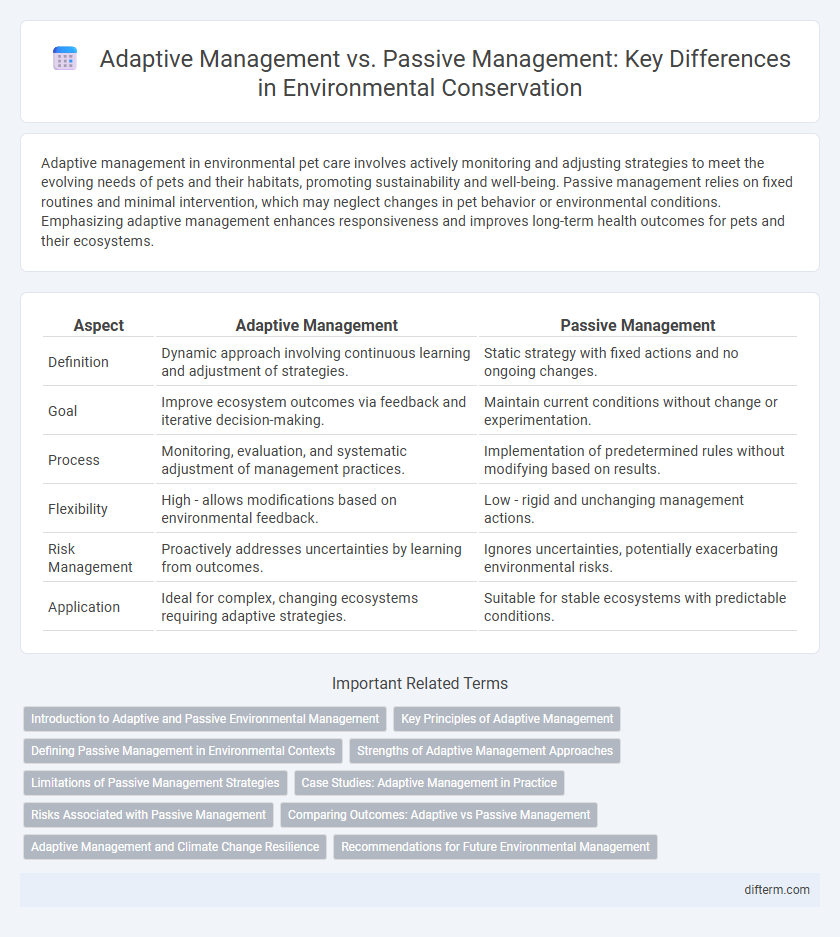Adaptive management in environmental pet care involves actively monitoring and adjusting strategies to meet the evolving needs of pets and their habitats, promoting sustainability and well-being. Passive management relies on fixed routines and minimal intervention, which may neglect changes in pet behavior or environmental conditions. Emphasizing adaptive management enhances responsiveness and improves long-term health outcomes for pets and their ecosystems.
Table of Comparison
| Aspect | Adaptive Management | Passive Management |
|---|---|---|
| Definition | Dynamic approach involving continuous learning and adjustment of strategies. | Static strategy with fixed actions and no ongoing changes. |
| Goal | Improve ecosystem outcomes via feedback and iterative decision-making. | Maintain current conditions without change or experimentation. |
| Process | Monitoring, evaluation, and systematic adjustment of management practices. | Implementation of predetermined rules without modifying based on results. |
| Flexibility | High - allows modifications based on environmental feedback. | Low - rigid and unchanging management actions. |
| Risk Management | Proactively addresses uncertainties by learning from outcomes. | Ignores uncertainties, potentially exacerbating environmental risks. |
| Application | Ideal for complex, changing ecosystems requiring adaptive strategies. | Suitable for stable ecosystems with predictable conditions. |
Introduction to Adaptive and Passive Environmental Management
Adaptive environmental management is a dynamic approach that incorporates continuous learning and feedback to adjust strategies in response to changing ecological conditions, enhancing ecosystem resilience. Passive management relies on fixed, predefined policies with minimal intervention, potentially leading to less effective responses in complex and evolving environmental systems. Emphasizing flexibility and real-time data integration, adaptive management offers a more effective framework for addressing uncertainty in environmental conservation.
Key Principles of Adaptive Management
Adaptive management emphasizes iterative learning, continuous monitoring, and flexible decision-making to address environmental uncertainties and dynamic ecosystems. It integrates stakeholder involvement and employs structured feedback loops to refine strategies based on observed outcomes. This approach contrasts with passive management, which relies on fixed plans without systematic evaluation or adjustment.
Defining Passive Management in Environmental Contexts
Passive management in environmental contexts involves minimal human intervention, allowing ecosystems to evolve naturally without active restoration or alteration efforts. This approach emphasizes observing and monitoring ecological processes, relying on natural resilience and self-recovery mechanisms to maintain biodiversity and ecosystem functions. It contrasts with adaptive management by prioritizing stability and preservation over continuous management adjustments.
Strengths of Adaptive Management Approaches
Adaptive management approaches excel in dynamic environmental conditions by promoting continuous learning and flexible decision-making, allowing for real-time adjustments based on monitoring results. This method enhances ecosystem resilience and biodiversity conservation by integrating scientific data with stakeholder input to effectively respond to uncertainties. Compared to passive management, adaptive management reduces risks of maladaptation and supports sustainable resource use through iterative evaluation and adaptive strategies.
Limitations of Passive Management Strategies
Passive management strategies often fail to respond effectively to dynamic environmental changes, leading to ecosystem degradation and loss of biodiversity. These approaches lack flexibility, resulting in delayed adaptation to climate shifts, invasive species, and habitat destruction. Consequently, passive management is less capable of sustaining ecological resilience compared to adaptive management practices.
Case Studies: Adaptive Management in Practice
Case studies of adaptive management in environmental conservation demonstrate significant improvements in ecosystem resilience and biodiversity recovery compared to passive management. Projects such as the Everglades restoration and Australia's Murray-Darling Basin illustrate how continuous monitoring and flexible decision-making lead to effective responses to ecological changes. Data-driven adaptive strategies optimize resource allocation, reduce risks, and enhance long-term sustainability outcomes.
Risks Associated with Passive Management
Passive management in environmental systems can lead to significant risks, including delayed response to ecosystem changes and inability to address emerging threats such as invasive species or climate variability. This approach often results in loss of biodiversity and degradation of natural resources due to rigid adherence to static management plans. Failure to implement adaptive monitoring and feedback mechanisms increases vulnerability to ecological surprises and long-term environmental instability.
Comparing Outcomes: Adaptive vs Passive Management
Adaptive management actively integrates monitoring and feedback to improve ecosystem resilience and biodiversity, resulting in more effective restoration and conservation outcomes. Passive management typically relies on fixed strategies with minimal adjustment, often leading to less responsive and slower recovery from environmental disturbances. Studies demonstrate that adaptive management yields higher success rates in habitat preservation and resource sustainability compared to passive approaches.
Adaptive Management and Climate Change Resilience
Adaptive management enhances climate change resilience by enabling continuous learning and flexible decision-making to address uncertain environmental conditions. It incorporates real-time monitoring and feedback loops, allowing ecosystems to adjust dynamically to shifting climate variables. This approach reduces vulnerability and supports sustainable resource management under unpredictable climate scenarios.
Recommendations for Future Environmental Management
Adaptive management encourages continuous learning and flexibility by monitoring environmental outcomes and adjusting strategies accordingly, enhancing ecosystem resilience. Passive management, characterized by fixed plans with minimal intervention, often fails to address dynamic ecological changes or unforeseen challenges. Future environmental management should prioritize adaptive frameworks integrating real-time data, stakeholder collaboration, and iterative decision-making to effectively respond to climate variability and biodiversity loss.
adaptive management vs passive management Infographic

 difterm.com
difterm.com